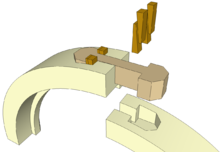Hammer-headed tenon


Hammer-headed tenonjoints are one method that can be used to join curved members ofjoinerycomponents.
The hammer-headed tenonis used to join a curved member to a straight member such as a curved head member to a jamb. Thetenonis formed on the jamb and the mortise to receive the tenon is formed on the curved member. The mortise is increased in size to receive a pair of foldingwedgeseach side of the tenon.
The hammer-headed keyis used where there is no straight member to form the tenon. It is difficult to form a strong tenon on curved cut timber as the shortgrainthere will weaken it, so two mortise sockets are formed one in each piece and a separate tenon piece called a key is formed to fit. As with the hammer-headed tenon the mortise sockets are increased in size to allow for the folding wedges each side of the tenon.
When the joint is fitted and glued together it is the folding wedges that give thecrampingeffect that tightens the shoulder of the joint.
Both these hammer-headed joints need good attention to detail from thejoineras they are difficult to make completely by machine or power tool.
Other joints that can be used on curved headed frames are:
Draw dowelled bridle or mortise
Handrail bolts and dowels
